阿姆斯特丹城市规划amsterdam-planning
- 格式:pdf
- 大小:2.39 MB
- 文档页数:1
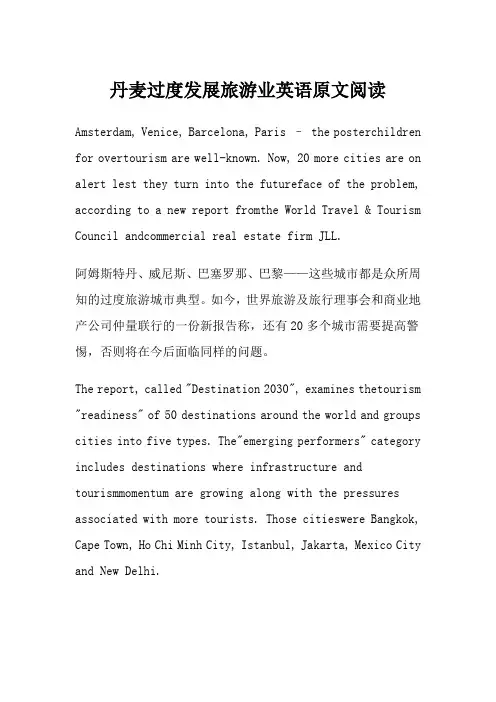
丹麦过度发展旅游业英语原文阅读Amsterdam, Venice, Barcelona, Paris – the posterchildren for overtourism are well-known. Now, 20 more cities are on alert lest they turn into the futureface of the problem, according to a new report fromthe World Travel & Tourism Council andcommercial real estate firm JLL.阿姆斯特丹、威尼斯、巴塞罗那、巴黎——这些城市都是众所周知的过度旅游城市典型。
如今,世界旅游及旅行理事会和商业地产公司仲量联行的一份新报告称,还有20多个城市需要提高警惕,否则将在今后面临同样的问题。
The report, called "Destination 2030", examines thetourism "readiness" of 50 destinations around the world and groups cities into five types. The"emerging performers" category includes destinations where infrastructure and tourismmomentum are growing along with the pressures associated with more tourists. Those citieswere Bangkok, Cape Town, Ho Chi Minh City, Istanbul, Jakarta, Mexico City and New Delhi.这份名为《2030年旅游目的地》的报告考察了全球50个旅游目的地的“接待能力”,并将这些城市分为五种类型。
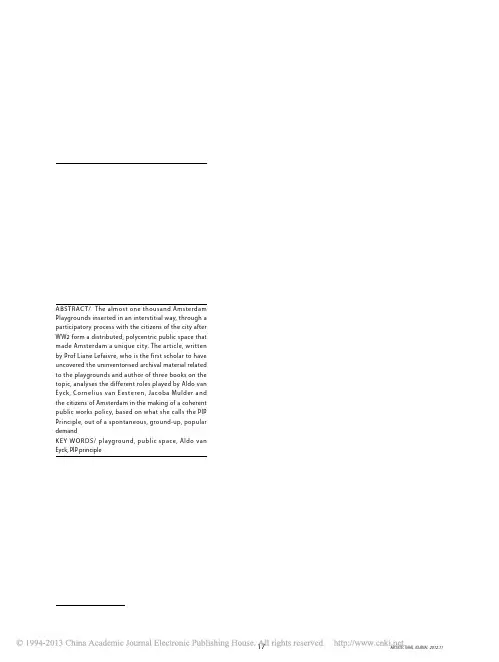
第二次世界大战到21世纪初始的60多年里,得益于阿姆斯特丹当地政府优越的民主制度,市民可以方便、快捷地向政府传达民意,这也促使了阿姆斯特丹的公共事务开始由政府决策向公众参与决策转变。
阿姆斯特丹户外活动空间的设计与发展则是草根阶层参与公共政策决策的典范。
1929-1947年,阿姆斯特丹的户外活动空间在数量上一直稳定在29个。
1947年,阿姆斯特丹的新公共事务部主管康乃利斯・范伊斯特伦(Cornelius van Eesteren)上任,提出了城市户外活动空间的增建计划,其中包括一系列的公共配套设施,例如公共电话亭、户外市场和公共厕所[1]。
从1947年起,阿姆斯特丹每年新建的户外活动场超过50处,逐渐覆盖了从旧城中心到城市西部新区:斯洛特迪克(Sloterdijk)、斯洛特米尔(Slotermeer)和古兹维尔德(Geuzeveld)的全部区域;截止1968年,阿姆斯特丹全城的户外活动空间总数超过1000处—一个令世界其他城市惊叹的数字(图1、2)。
1 战后重建阿姆斯特丹的户外活动空间建设具有4大特点:1)其自下而上、公众参与的规划决策过程。
在阿姆斯特丹的城市档案中还保留有190多封市民来信,呼吁政府新建城市户外活动场,这些档案上还留存有许多政府工作人员的批注印迹。
这些档案是阿姆斯特丹市民参政议政的缩影,更反映了政府和市民同心协力为城市发展所做的大量细致工作1);2)新建的户外活动空间不仅没有破坏现有的城市肌理,反而修补了由城市更新所造成的城市肌理的断裂;3)这些户外活动空间呈多中心式网络分布,环绕各个城市居住区构成了微型的城市聚落;4)虽然项目一般起始于市民或社会团体自发性的提议,但这些提议在政府公共部门的主导下可以转化为具有法律效应的规划政策,从而保证规划及建设项目能够切实反映公众意愿。
这种强调公众参与(participatory)、空间嵌入(interstitial)和多中心网络(polycentered)的发展原则简称为PIP 原则。
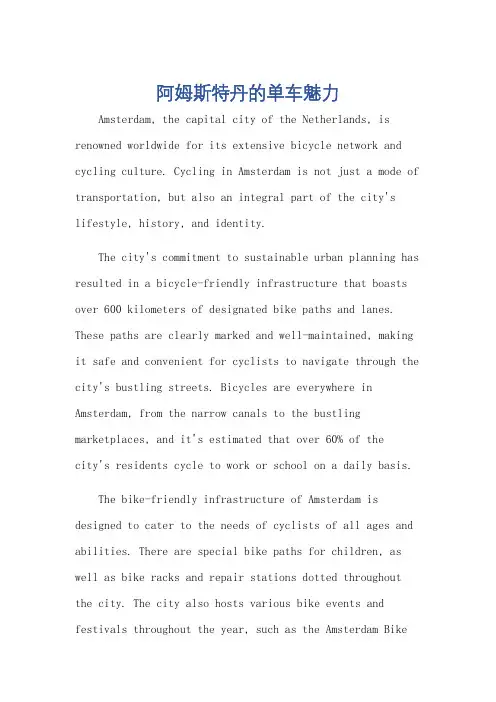
阿姆斯特丹的单车魅力Amsterdam, the capital city of the Netherlands, is renowned worldwide for its extensive bicycle network and cycling culture. Cycling in Amsterdam is not just a mode of transportation, but also an integral part of the city's lifestyle, history, and identity.The city's commitment to sustainable urban planning has resulted in a bicycle-friendly infrastructure that boasts over 600 kilometers of designated bike paths and lanes. These paths are clearly marked and well-maintained, making it safe and convenient for cyclists to navigate through the city's bustling streets. Bicycles are everywhere in Amsterdam, from the narrow canals to the bustling marketplaces, and it's estimated that over 60% of thecity's residents cycle to work or school on a daily basis. The bike-friendly infrastructure of Amsterdam is designed to cater to the needs of cyclists of all ages and abilities. There are special bike paths for children, as well as bike racks and repair stations dotted throughout the city. The city also hosts various bike events and festivals throughout the year, such as the Amsterdam BikeWeek, which attracts thousands of cycling enthusiasts from around the world.The popularity of cycling in Amsterdam can beattributed to several factors. Firstly, the city's compact size and dense urban fabric make it ideal for cycling. Secondly, the Netherlands has a long-standing tradition of cycling, dating back to the 19th century when the first bicycles were invented. This tradition has been preserved and nurtured over the years, resulting in a cycling culture that is deeply ingrained in the Dutch way of life.Moreover, the Netherlands government has always been committed to promoting cycling as a sustainable mode of transportation. This commitment is evident in the city's infrastructure investments, as well as in its policies that encourage cycling. For instance, the government provides subsidies for bicycle purchases and maintenance, and it also offers discounted public transport fares for cyclists. The benefits of cycling in Amsterdam are numerous. Itis an efficient and cost-effective mode of transportation that helps reduce congestion and air pollution. It also promotes physical activity and improves overall health andwell-being. Cycling in Amsterdam is a great way to explore the city's unique architecture, culture, and landscapes. From the iconic windmills and canal houses to the vibrant art galleries and museums, there is so much to see and discover on two wheels.In conclusion, Amsterdam is a city that truly embodies the spirit of cycling. Its extensive bicycle network, bike-friendly infrastructure, and cycling culture make it a paradise for cyclists from around the world. Cycling in Amsterdam is not just a means of getting around, it's an experience that is rich in history, culture, and adventure. So, if you're ever in Amsterdam, make sure to bring your bike and experience the city like a local!**阿姆斯特丹的单车魅力**阿姆斯特丹,作为荷兰的首都,因其广泛的自行车网络和深厚的骑行文化而在全球享有盛誉。
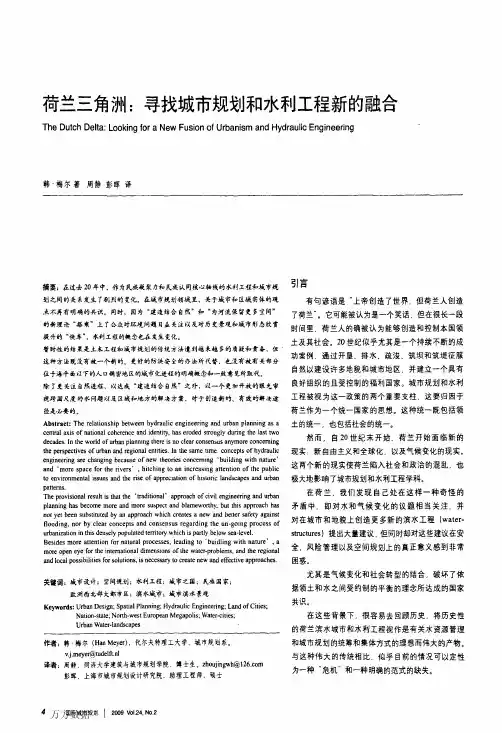
万方数据荷兰三角洲寻找城市规划和水利工程新的融合..但是.果真如此吗7与水资源管理相关的荷兰城市规划的传统真是如此集体化和统筹的吗7而当今状态真的与这种传统形成了如此大的差异7我们对这一说法表示怀疑。
在荷兰低地,城市水资源管理的道路上遍布冲突:在水务董事会与城市之间.在农村.农业社区与城市经济体之间,在民事与军事目标之间.在地方与区域/国家利益之间.在公共与私人利益之间,以及最近发生的经济与生态之间和科技成效与文化历史的增值之间。
关于城市规划和水资源管理的;中突和”危机“并不是一个新问题,但由于各种情况和条件的不断变化.这些冲突的特征也正在发生改变。
要考虑的最重要的问题是有关解决和处理这些冲突的尺度。
考虑到尺度问题,我们可以看到与当今形势明显不同的前两个时期:”城市之国”fLandofCities)成长时期(13一18世纪)及民族国家时期(19—20世纪)。
关于城市规划和水资源管理联系的方式和解决办法,两个时期相当不同。
对于现在和未来而言,民族国家的方法的延续,以及对”城市之国”时期概念的怀旧性回归似乎都已经不再富有成效。
城市之国:城市设计和水利工程之间的融合四个城市系统从荷兰城市化进程开始——首次是在罗马时期.之后从1l世纪开始——荷兰低地的城市化进程与水基础设施和水资源管理直接相关。
在罗马时期,第一批城市定居点像马斯特里赫特(Maastricht)和奈梅亨(Nijmcgen)一样,沿着马斯河和莱茵河定居。
河流是重要的防御线(莱茵河是罗马帝国的边界)和运输基础设施:定居点位于天然高地和水患安全地带。
12至15世纪.与国际“汉萨同盟“(Hanze—league)有关的第一批荷兰贸易城市.同样也主要建在沿着河岸的高地之上(Rune,vanEngen,2005)。
排水和清淤技术的发展,为荷兰低地两个大的河口——莱茵河~斯海尔德河河口和须德海河口——的周边地区的城市化转变创造了条件。
这两个河口地区对城市化进程来说,既是极其困难的.也是极具吸引力的:困难是因为这片地区的多沼泽环境和洪水所带来的威胁;而有吸引力则是因为邻近富饶的渔场,适于种植的肥沃土壤.以及对于港口发展.贸易和商业有利的条件。
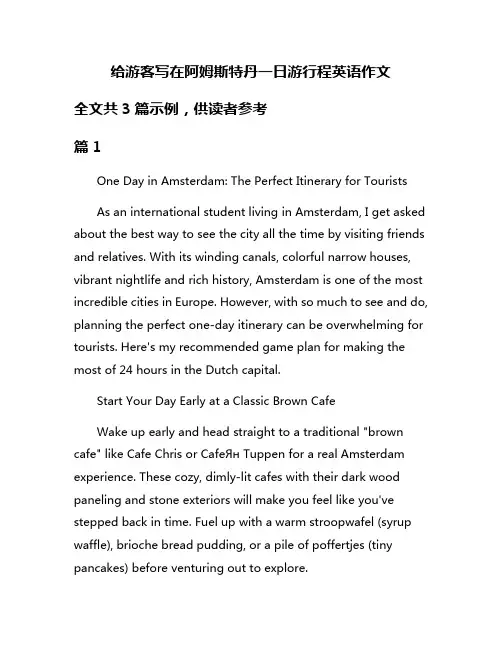
给游客写在阿姆斯特丹一日游行程英语作文全文共3篇示例,供读者参考篇1One Day in Amsterdam: The Perfect Itinerary for TouristsAs an international student living in Amsterdam, I get asked about the best way to see the city all the time by visiting friends and relatives. With its winding canals, colorful narrow houses, vibrant nightlife and rich history, Amsterdam is one of the most incredible cities in Europe. However, with so much to see and do, planning the perfect one-day itinerary can be overwhelming for tourists. Here's my recommended game plan for making the most of 24 hours in the Dutch capital.Start Your Day Early at a Classic Brown CafeWake up early and head straight to a traditional "brown cafe" like Cafe Chris or CafeЯн Tuppen for a real Amsterdam experience. These cozy, dimly-lit cafes with their dark wood paneling and stone exteriors will make you feel like you've stepped back in time. Fuel up with a warm stroopwafel (syrup waffle), brioche bread pudding, or a pile of poffertjes (tiny pancakes) before venturing out to explore.Walk the Canals of GrachtengordelWith a belly full of Dutch goodies, it's time to walk off your breakfast by meandering through Grachtengordel, Amsterdam's iconic canal district. This 17th century neighborhood of concentric semi-circular canals lined with beautifully preserved merchanthouses is a UNESCO World Heritage site and the stunning centerpiece of the city. Wander the Prinsengracht, Keizersgracht, and Herengracht waterways, crossing over picturesque bridges and popping into any interesting shops, cafes or pubs that catch your eye along the way. Don't miss taking a photo at the famous Seven Bridges connecting the major canals.Visit the Anne Frank HouseAfter a few hours of wandering the canals, walk or take a tram to the Anne Frank House, located on Prinsengracht canal. This sobering museum chronicles the incredible story of the young Jewish diarist who hid from the Nazis in a secret annex of the house during World War II. Buy your tickets well in advance online as lines can be insanely long. The self-guided tour through the indelibly powerful secret annex provides heartbreaking insight into Anne's daily life in hiding. Seeing thecramped living quarters and reading excerpts from her diary is a profoundly moving experience everyone should have.Have a Picnic Lunch in VondelparkEscape the crowds and grab a quick lunch to go from one of the beloved snack stands or markets like Albert Cuyp. Pick up a fresh stroopwafel, frites (fries) smothered in dutch mayonnaise, a haring (herring) sandwich or kwark (a thick yogurt) with strawberries. Then stroll over to Vondelpark, Amsterdam's version of Central Park, to enjoy your picnic on the sprawling green lawns surrounded by locals soaking up some fresh air. Keep an eye out for the park's famous punctual dogs who queue up to be let off their leashes at precisely 9am and 9pm each day!See Amsterdam from the WaterNo visit to Amsterdam is complete without a canal cruise to get a different vantage point of the city's iconic waterways and architecture. Hop aboard one of the glass-topped boat tours which depart regularly throughout the day from major centrally located docks. Most are an hour long and provide an entertaining, informative narration about Amsterdam's history and top sights as you glide under bridges and past 17th century homes, churches and houseboats. Splurge on a fancier evening cruise paired with dinner or drinks for a romantic way toexperience Amsterdam's canals aglow with lights reflecting off the water.Explore One of Amsterdam's World-Class MuseumsAfter your canal cruise, spend a few hours admiring the unparalleled collection at one of Amsterdam's acclaimed museums like the Rijksmuseum, Van Gogh Museum or Stedelijk Museum. The massive Rijksmuseum houses an incredible collection of Dutch art and artifacts including Rembrandt's famous The Night Watch painting and Vermeer's masterpieces. For fans of the tormented artist, the Van Gogh Museum houses the world's largest collection of his vibrant paintings and personal artifacts. Meanwhile, the Stedelijk has an incredible modern and contemporary art collection with works by Picasso, Warhol and more.End Your Night in the Red Light DistrictNo Amsterdam itinerary would be complete without at least swinging through De Wallen, the city's iconic Red Light District centered around a network of narrow alleys full of casinos, sex shops and coffee houses. While the area definitely has a seedy vibe with semi-nude sex workers posing brazenly in the infamous red-lit window cabins, it's also strangely thrilling just to wander around and take it all in. Grab a pre-dinner cocktail atone of the thumping neon-lit clubs or cozy up with a beer at one of the district's classic brown bars as you watch the raucous, colorful crowds go by. For your last hurrah, head to the lively Leidseplein square full of restaurants, bars and nightclubs bumping with partiers from every corner of the globe.With efficient planning and an open mind, you can certainly experience the very best of what Amsterdam has to offer in just 24 hours. From historic sights to world-class museums to cafe culture to one of the most bizarre nightlife scenes on Earth, this dynamic city truly has it all packed into a relatively compact, walkable area. One day here will surely leave you in love with Amsterdam's free-spirited charisma and hungry to come back for more.篇2A One Day Itinerary for Tourists in AmsterdamHey there! If you're planning a trip to the Netherlands and only have a single day to explore the vibrant city of Amsterdam, don't worry – I've got you covered! As a local student studying here, I've had the chance to intimately experience the city's rich culture, captivating history, and unique attractions. In this essay, I'll share with you an action-packed one-day itinerary that willallow you to make the most of your time in the Venice of the North.Let's start our day bright and early at 8 AM with a quintessential Dutch experience: a hearty breakfast at one of Amsterdam's cozy cafés. I recommend trying the renowned Dutch pancakes, known as "poffertjes," or indulging in a delicious "uitsmijter" – an open-faced sandwich with ham, cheese, and eggs. Fuel up with a strong cup of coffee or hot chocolate, because we've got a jam-packed day ahead of us!After breakfast, it's time to immerse yourself in Amsterdam's rich history by visiting the Anne Frank House (Anne Frankhuis) at 9 AM. This poignant museum is located in the very house where the young diarist and her family hid from the Nazis during World War II. As you walk through the cramped quarters and read excerpts from her famous diary, you'll gain a profound understanding of the struggles and resilience of the Jewish people during the Holocaust. Be sure to book your tickets in advance, as the museum can get quite crowded.Next, we'll hop on a classic Amsterdam experience – a canal cruise – at 11 AM. These leisurely boat tours offer a unique perspective of the city, allowing you to admire the charming canal houses, historic bridges, and picturesque scenes that havemade Amsterdam famous. As you glide along the waterways, your knowledgeable guide will regale you with fascinating stories and anecdotes about the city's past and present.After disembarking from the canal cruise, it's time for a well-deserved lunch break at around 1 PM. Head over to the Albert Cuyp Market, one of Amsterdam's most famous and lively street markets. Here, you'll find an incredible array of food stalls offering delectable Dutch treats, fresh produce, and international cuisine. Grab a savory Dutch snack like a "frikandel" (a delicious deep-fried sausage) or a classic "broodje haring" (a sandwich with pickled herring), and soak in the vibrant atmosphere of this bustling market.With our stomachs full, we'll continue our exploration of Amsterdam's cultural heritage by visiting the Rijksmuseum at 3 PM. This world-renowned museum houses an incredible collection of Dutch art and artifacts, including masterpieces by Rembrandt, Vermeer, and Frans Hals. Wander through the galleries, marvel at the intricate details of the Golden Age paintings, and immerse yourself in the rich artistic traditions of the Netherlands.After soaking in the cultural riches of the Rijksmuseum, it's time to shift gears and experience Amsterdam's quirky andunconventional side. At around 5 PM, we'll head to the famous Red Light District, locally known as "De Wallen." While this area is known for its legal sex trade, it's also a fascinating neighborhood with a unique atmosphere and rich history. Stroll along the narrow streets, admire the historic buildings, and learn about the city's progressive approach to social issues.As the evening sets in, it's time to indulge in one of Amsterdam's most beloved traditions: enjoying a drink or two in one of the city's cozy "brown cafés." These traditional pubs, often adorned with warm wood paneling and dimly lit interiors, offer a cozy respite from the hustle and bustle of the city. Grab a refreshing Dutch beer (I recommend trying a Grolsch or Heineken) or a jenever (Dutch gin) and mingle with the friendly locals.Finally, cap off your whirlwind day in Amsterdam with a delectable Dutch dinner at around 8 PM. I suggest trying the classic "stamppot" – a hearty dish consisting of mashed potatoes mixed with vegetables, smoked sausage, and bacon. Or, if you're feeling adventurous, sample the famous "bitterballen" –deep-fried meatballs typically served as a snack or appetizer. No matter what you choose, you're sure to leave with a satisfied palate and a deeper appreciation for Dutch cuisine.As you can see, Amsterdam is a city that offers an incredible blend of history, culture, and modern-day charm. With thisone-day itinerary, you'll get a taste of the city's rich tapestry, from its somber past to its vibrant present. Of course, there's always more to explore in this captivating city, but if you only have a single day, this itinerary will ensure that you make the most of your time in the Venice of the North.Happy travels, and don't forget to pack your walking shoes and a sense of adventure! Amsterdam awaits.篇3A Picturesque Day in Amsterdam: A Tourist ItineraryAs an international student studying in the Netherlands, I have had the chance to explore Amsterdam on numerous occasions. This vibrant city, renowned for its charming canals, rich history, and diverse culture, offers an abundance of experiences for visitors. Today, I'll take you on a journey through Amsterdam, sharing my personal recommendations for an unforgettable one-day adventure.9:00 AM: Start Your Day at the Anne Frank HouseBegin your Amsterdam experience by visiting the Anne Frank House, a somber yet powerful reminder of one of thedarkest periods in human history. This museum, located in the former hiding place of the Frank family during World War II, offers a poignant glimpse into the life of Anne Frank and the struggles endured by countless Jewish families during the Nazi occupation. Advance ticket purchase is highly recommended to avoid long queues.11:00 AM: Embrace the Beauty of the Canal BeltAfter your visit to the Anne Frank House, immerse yourself in the enchanting atmosphere of Amsterdam's UNESCO-listed Canal Belt. Take a leisurely stroll along the picturesque canals, admiring the iconic Dutch architecture, charming bridges, and houseboats lining the waterways. Stop for a coffee or hot chocolate at one of the cozy cafés nestled along the canals, and soak in the quintessential Amsterdam ambiance.12:30 PM: Indulge in Dutch DelicaciesNo visit to Amsterdam would be complete without savoring the local cuisine. Head to the Albert Cuyp Market, one of the largest and most renowned outdoor markets in the city. Here, you'll find an array of stalls offering traditional Dutch treats, such as stroopwafels (syrup waffles), poffertjes (mini pancakes), and fresh herring sandwiches. Grab a bite to eat and immerse yourself in the lively market atmosphere.2:00 PM: Explore the RijksmuseumAfter fueling up on Dutch delicacies, it's time to delve into Amsterdam's cultural heritage at the renowned Rijksmuseum. This world-class museum houses an extensive collection of Dutch art and historical artifacts, including masterpieces by Rembrandt, Vermeer, and Frans Hals. Spend a few hours wandering through the galleries, marveling at the incredible works of art that have shaped the Netherlands' artistic legacy.4:30 PM: Relax in the VondelparkAfter an enriching cultural experience, escape the city's bustle and enjoy some tranquility in the Vondelpark. This vast urban park, located in the heart of Amsterdam, is a favorite gathering spot for locals and visitors alike. Rent a bicycle or take a leisurely stroll along the winding paths, admiring the lush greenery, ponds, and open-air theaters. If the weather permits, pack a picnic and find a cozy spot on the grass to unwind and soak in the park's serene atmosphere.6:30 PM: Witness the Charm of the Red Light DistrictNo visit to Amsterdam would be complete without exploring the infamous Red Light District. While this area is known for its adult entertainment, it also offers a unique glimpse intoAmsterdam's history and culture. Stroll along the narrow streets, admiring the iconic red-lit windows and the picturesque canals that wind through the district. Stop for a drink at one of the lively cafés or bars and immerse yourself in the vibrant atmosphere.8:00 PM: Indulge in a Canal CruiseAs the day draws to a close, embark on a romantic canal cruise, offering a different perspective of Amsterdam's enchanting waterways. Glide past historic bridges, charming houseboats, and iconic landmarks, while learning about the city's fascinating history from your knowledgeable guide. This tranquil experience is the perfect way to cap off your day in Amsterdam, allowing you to take in the city's beauty from a unique vantage point.10:00 PM: Savor the NightlifeAfter your canal cruise, Amsterdam's lively nightlife awaits. Head to the Leidseplein or Rembrandtplein areas, where you'll find an array of bars, clubs, and live music venues catering to every taste. Whether you're in the mood for a cozy pub, a lively dance club, or a jazz bar, Amsterdam's nightlife scene has something to offer everyone.As the night draws to a close, you'll return to your accommodation with cherished memories and a newfound appreciation for the beauty, history, and vibrant culture that make Amsterdam a truly remarkable destination.Remember, this itinerary is merely a suggestion, and the beauty of Amsterdam lies in its ability to cater to diverse interests and preferences. Feel free to explore at your own pace, discover hidden gems, and create your own unique experiences in this captivating city.。
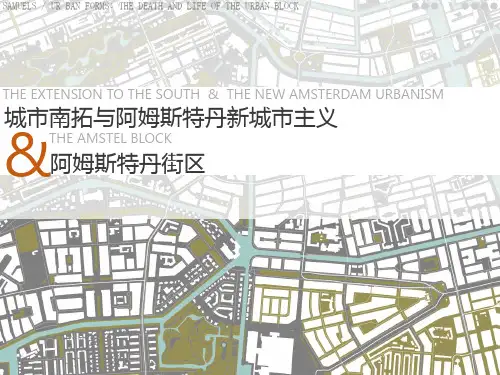
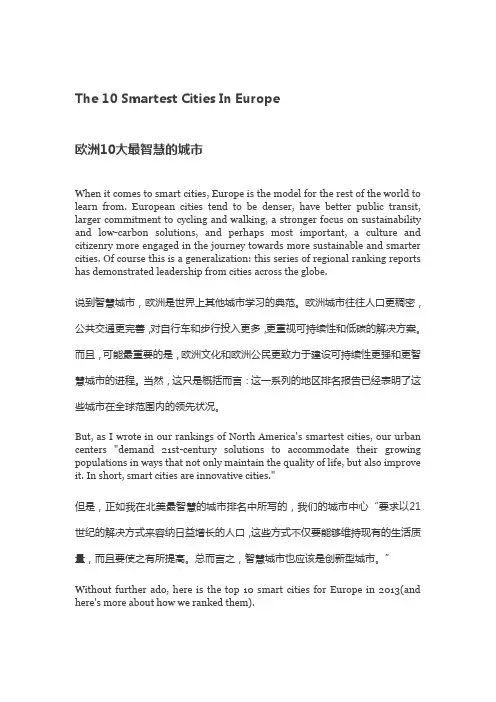
The 10 Smartest Cities In Europe欧洲10大最智慧的城市When it comes to smart cities, Europe is the model for the rest of the world to learn from. European cities tend to be denser, have better public transit, larger commitment to cycling and walking, a stronger focus on sustainability and low-carbon solutions, and perhaps most important, a culture and citizenry more engaged in the journey towards more sustainable and smarter cities. Of course this is a generalization: this series of regional ranking reports has demonstrated leadership from cities across the globe.说到智慧城市,欧洲是世界上其他城市学习的典范。
欧洲城市往往人口更稠密,公共交通更完善,对自行车和步行投入更多,更重视可持续性和低碳的解决方案。
而且,可能最重要的是,欧洲文化和欧洲公民更致力于建设可持续性更强和更智慧城市的进程。
当然,这只是概括而言:这一系列的地区排名报告已经表明了这些城市在全球范围内的领先状况。
But, as I wrote in our rankings of North America's smartest cities, our urban centers "demand 21st-century solutions to accommodate their growing populations in ways that not only maintain the quality of life, but also improve it. In short, smart cities are innovative cities."但是,正如我在北美最智慧的城市排名中所写的,我们的城市中心“要求以21世纪的解决方式来容纳日益增长的人口,这些方式不仅要能够维持现有的生活质量,而且要使之有所提高。

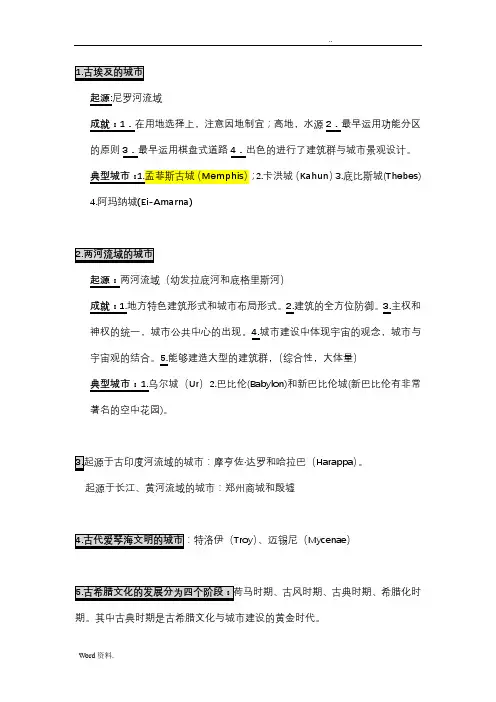
起源:尼罗河流域成就:1.在用地选择上,注意因地制宜;高地,水源2.最早运用功能分区的原则3.最早运用棋盘式道路4.出色的进行了建筑群与城市景观设计。
2.卡洪城(Kahun)3.底比斯城(Thebes)4.阿玛纳城(Ei-Amarna)起源:两河流域(幼发拉底河和底格里斯河)成就:1.地方特色建筑形式和城市布局形式。
2.建筑的全方位防御。
3.主权和神权的统一,城市公共中心的出现。
4.城市建设中体现宇宙的观念,城市与宇宙观的结合。
5.能够建造大型的建筑群,(综合性,大体量)典型城市:1.乌尔城(Ur)2.巴比伦(Babylon)和新巴比伦城(新巴比伦有非常著名的空中花园)。
Harappa)。
起源于长江、黄河流域的城市:郑州商城和殷墟Troy)、迈锡尼(Mycenae)期。
其中古典时期是古希腊文化与城市建设的黄金时代。
6.希腊化时期城市建设特征:(1)大多按希波丹姆规划系统进行规划建设,以棋盘式道路网布置,并开始研究功能分区,以地域性形成的聚落到城市在希波战争中被破坏。
(2)建筑艺术的价值降低,不是平民的建筑,而是为贵族所建。
(3)新的城市中心是广场,广场规整、划一。
(4)共和制城邦国解体,形成奴隶制国家,建筑可以以其自身体系与高度突出自己。
7.阐述希波丹姆规划模式(Hippodamus planning model )。
希波丹姆规划型式遵循古希腊哲理,探求几何和数的和谐,从秩序美的角度出发,采用几何形状,以棋盘路为城市的骨架,以城市广场为中心,以充分体现了民主和平等的城邦精神,在后来的城市规划实践中被广泛的运用。
该模式通常把城市分为3部分:圣地、主要公共建筑区、私宅地段(工匠住区、农民住区、城邦卫士与公职人员住区)。
米利都(Miletus)和普林南(Priene)均是按照希波丹姆斯的风格进行规划设计的城市。
8. 绘制雅典(Athens)卫城的平面图,并说明其建设特点。
雅典卫城建设特点:(1)选址:位于雅典城中心的相对独立的山岗上,高于地面70m,视觉及景观上都能控制全城。
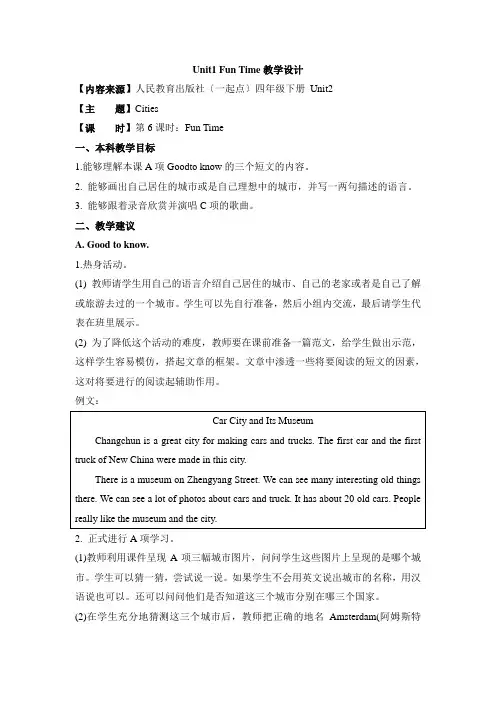
Unit1 Fun Time教学设计【内容来源】人民教育出版社〔一起点〕四年级下册Unit2【主题】Cities【课时】第6课时:Fun Time一、本科教学目标1.能够理解本课A项Goodto know的三个短文的内容。
2. 能够画出自己居住的城市或是自己理想中的城市,并写一两句描述的语言。
3. 能够跟着录音欣赏并演唱C项的歌曲。
二、教学建议A. Good to know.1.热身活动。
(1) 教师请学生用自己的语言介绍自己居住的城市、自己的老家或者是自己了解或旅游去过的一个城市。
学生可以先自行准备,然后小组内交流,最后请学生代表在班里展示。
(2) 为了降低这个活动的难度,教师要在课前准备一篇范文,给学生做出示范,这样学生容易模仿,搭起文章的框架。
文章中渗透一些将要阅读的短文的因素,这对将要进行的阅读起辅助作用。
例文:2. 正式进行A项学习。
(1)教师利用课件呈现A项三幅城市图片,问问学生这些图片上呈现的是哪个城市。
学生可以猜一猜,尝试说一说。
如果学生不会用英文说出城市的名称,用汉语说也可以。
还可以问问他们是否知道这三个城市分别在哪三个国家。
(2)在学生充分地猜测这三个城市后,教师把正确的地名Amsterdam(阿姆斯特丹〕,London(伦敦〕,Copenhagen (哥本哈根〕书写在黑板上,并带着学生朗读这三个城市名,这三个城市名中有两个字母较多,也不好发音,教师要特别帮助学生准确发音。
(3)教师指着Amsterdam继续引导提问:What do you know about Amsterdam为了帮助学生能开动脑筋,教师课前准备数张阿姆斯特丹的城市街景图片,尤其是交通情况的图片,供学生讨论用。
(4)留给学生一定的时间讨论,并在全班分享他们所知道的这个城市的情况。
教师将学生提到的与本单元话题有关的词汇,写在黑板上。
(5)教师接着说:OK. Now let’s listen to a passage about Amsterdam. Listen carefully and make notes when you are listing. Answer the question after listening. What does it mainly talk about(6)请学生听Bicycle City的录音。
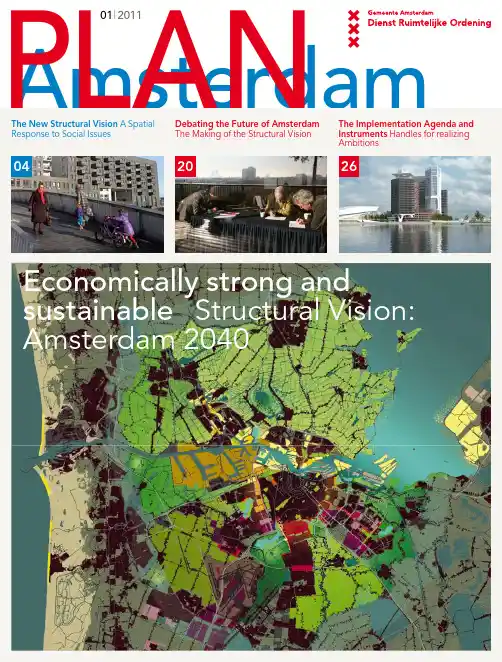
未来城市设计与可持续发展:构筑宜居美好的城市1. Introduction1.1 OverviewIn recent years, the concept of sustainable development has gained significant attention worldwide, as it is crucial to ensure a better quality of life for future generations while preserving the environment. One crucial aspect of achieving sustainability is through the design and development of cities. Urban areas play a vital role in fostering economic growth, social progress, and environmental preservation. This article aims to explore the relationship between city design and sustainable development, highlighting the importance of constructing livable and vibrant cities.1.2 Article StructureThe article is structured into five sections that delve into various aspects of future city design towards sustainable development.Section 2 focuses on understanding the relationship between city design and sustainable development. It discusses the concept of sustainable development, its significance in urban planning, and how citydesign influences sustainability principles.Section 3 explores emerging trends and innovations in future city design. It examines the incorporation of smart technologies in urban planning, emphasizes the integration of green building practices and eco-friendly concepts with a focus on creating ecologically sound cities, and highlights community engagement within urban planning and design processes.Section 4 presents practical case studies showcasing successful endeavors in constructing livable cities. It analyzes exemplary projects such as Singapore's garden city model, Amsterdam's cyclist-friendly infrastructure, and Tianjin Binhai New Area's demonstration zone for an ecological and intelligent new city.Finally, Section 5 concludes this article by discussing the importance of balancing sustainability with livability in future urban developments. It emphasizes the need for collaborative efforts among urban designers, governments, and residents to ensure a harmonious approach towards urban planning. Additionally, it encourages further implementation and promotion of innovative ideas in future city designs.1.3 PurposeThe purpose of this article is to shed light on the significance of considering sustainable development in urban planning processes. By exploring various aspects of city design and its impact on sustainability, this article aims to inspire individuals, governments, and urban planners to adopt more innovative approaches in shaping cities for a better future. It also serves as a compilation of practical case studies that exemplify successful implementations of sustainable city design principles. Ultimately, this article seeks to promote a holistic approach towards constructing livable and environmentally conscious cities.2. 城市设计与可持续发展的关系2.1 可持续发展的概念和重要性可持续发展是指满足当代需求而不损害后代满足需求的能力。
荷兰的现代设计发展情况荷兰的现代设计发展情况荷兰是西欧的⼀个⼯业⾼度发达的国家,这个国家具有相当悠久的⽂明历史,在⽂艺复兴之后,⼀度是海上的强权国家,并且具有发达的殖民主义历史,其海外殖民地⼀直遍及远东,印度尼西亚就是⼀个前荷兰殖民地。
第⼆次世界⼤战结束以来,荷兰进⼈资本主义经济的稳健发展阶段,通过⼏⼗年的发展,现在的荷兰已经是世界最富裕的国家之⼀,拥有发达的⼯业、农业、旅游业和⾦融业,其海上运输在世界上具有举⾜轻重的地位。
因为⼯业的发达,也直接促进了它的⼯业设计、平⾯设计的发展,荷兰具有相当⾼⽔平的设计。
由于它与德国等国家的长期密切关联,因此荷兰的设计也具有明显的理性主义、功能主义特征。
这种特征可以从它的最⼤的企业飞利浦公司的产品与平⾯设计中看出来。
荷兰是⼀个⼈⼝密度⽐较⾼的西欧国家,它总⼈⼝为l , 500多万(1991 年统计),⽽国⼟⾯积却只有10 , 000 多平⽅英⾥,因此⼈⼝密度是每平⽅英⾥接近1 , 000 ⼈,其中城市⼈⼝为88 % , ⽐较美国的每平⽅英⾥60 余⼈,⾼出10 多倍。
因此,这个国家的都市⾮常发达,公⽤设施、公⽤住房、公共交通的设计都⾮常完善。
虽然是⼀个完整的国家,但是却具有类似新加坡、圣马利诺、列⽀敦⼠登这种所谓的城市国家的设计特征,在某种程度上与⼈⼝⾼度稠密的⽇本有相似之处。
荷兰同时是⼀个种族单⼀的国家,⼈⼝的97 %都是荷兰⼈,因此,在设计上也显⽰出⽂化单⼀(homogeniusity)的趋向,使⽤荷兰语。
荷兰的宗教信仰以天主教为多,⼈⼝中的40%信奉罗马天主教,另外有19 %左右的⼈⼝信奉基督教的⼀个分⽀-荷兰新教。
荷兰是⼀个领⼟⾮常狭⼩的国家,⾯积为15 , 770 平⽅英⾥,等于美国新英格兰地区的马萨诸塞州、康州和罗得岛州三州的⾯积。
位于欧洲的西北⾓的荷兰,北临北海,地势平坦低洼,不少地⽅低于海平⾯,依靠1 , 500 英⾥的⼤堤坝保护。
1920 年以来,政府开始排⼲伊塞⽶地区(IJsselmeer)的海⽔,形成⼀个⼈造的陆地,称为祖德兹地区(the zuider Zee ) ,是欧洲最⼤的填海⼯程之⼀。
AmsterdamCity and municipalityClockwise from top: Skyline of Amsterdam, buildings in Amsterdam, De Wallen (red light district), Dam Square,skyscrapers in Amsterdam, a cannabis coffee shop, canalsof AmsterdamFlagCoat of armsNickname(s): Mokum, Venice of the North Motto: Heldhaftig, Vastberaden, Barmhartig(Valiant, Steadfast, Compassionate)Location in North HollandCoordinates: 52°22′N 4°54′ECountry Netherlands Province North Holland Boroughs Government [1]• Body Municipal councilAmsterdamFrom Wikipedia, the free encyclopediaAmsterdam (English /ˈæmst ərdæm/;Dutch: [ˌʔɑmst ər ˈdɑm] ( )) is the capital city and most populous city of the Kingdom of the Netherlands. Its status as the Dutch capital is mandated by theConstitution of the Netherlands [7] though it is not the seat of the Dutch government, which is The Hague.[8]Amsterdam has a population of 813,562within the city-proper, 1,112,165 in the urban region and 1,575,263 in the greater metropolitan area.[9] The city itself,contrary to the Dutch national institute of statistics, calculates the number of inhabitants in the greater metropolitan area to be 2,332,773.[10] The city is located in the province of North Holland in the west of the country. It comprises much of the northern part of the Randstad,one of the larger conurbations in Europe,with a population of approximately 7 million.[11]Amsterdam's name derives fromAmstelredamme ,[12] indicative of the city's origin as a dam of the river Amstel.Originating as a small fishing village in the late 12th century, Amsterdam became one of the most important ports in the world during the Dutch Golden Age (17th century), a result of its innovative developments in trade. During that time,the city was the leading center forfinance and diamonds.[13] In the 19th and 20th centuries, the city expanded, and many new neighborhoods and suburbs were planned and built. The 17th-century canals of Amsterdam and the 19–20th century Defence Line of Amsterdam are on the UNESCO World Heritage List.As the commercial capital of theNetherlands and one of the top financial centres in Europe, Amsterdam is considered an alpha world city by the Globalization and World Cities (GaWC) study group. The city is also the cultural capital of the Netherlands.[14] Many large Dutch institutions have their headquartersCoordinates: 52°22′N 4°54′E8 districts• Mayor Eberhard van der Laan (PvdA)Area [2][3] • Municipality 219.32 km 2 (84.68 sq mi) • Land 165.76 km 2 (64.00 sq mi) • Water 53.56 km 2 (20.68 sq mi) • Randstad 3,043 km 2 (1,175 sq mi)Elevation [4]2 m (7 ft)Population (municipality, May 2014; urban and metro, May 2014; Randstad, 2011)[3][5][6] • Municipality 813,562 • Density 4,908/km 2 (12,710/sq mi) • Urban 1,112,165 • Metro1,575,263 • Metropolitan Area 2,332,773 • Randstad 6,979,500DemonymAmsterdammer Time zoneCET (UTC+1) • Summer (DST)CEST (UTC+2)Postcode 1000–1109Area code 020Websitewww.amsterdam.nl(http://www.amsterdam.nl)there, and seven of the world's 500largest companies, including Philips and ING, are based in the city.[15] In 2012,Amsterdam was ranked the second best city in which to live by the Economist Intelligence Unit (EIU) [16] and 12th globally on quality of living byMercer.[17] The city was previously ranked 3rd in innovation by 2thinknow in the Innovation Cities Index 2009.[18]The Amsterdam Stock Exchange, the oldest stock exchange in the world, is located in the city center. Amsterdam's main attractions, including its historic canals, the Rijksmuseum, the Van Gogh Museum, Stedelijk Museum, Hermitage Amsterdam, Anne Frank House, Amsterdam Museum, its red-light district, and its many cannabis coffee shops draw more than 3.66 million international visitors annually.Contents1 History1.1 Etymology1.2 Founding and Middle Ages 1.3 Conflict with Spain 1.4 Center of the Dutch Golden Age1.5 Decline and modernization 1.6 Twentieth century 1.7 Twenty-first century 2 Geography2.1 Venice of the North 2.2 Climate 3 Demographics3.1 Religious history 3.2 Tolerance and ethnic tension4 Cityscape and architecture4.1 Canals 4.2 Expansion 4.3 Architecture4.4 Parks and recreationalareas5 Economy5.1 Tourism5.1.1 Red light district5.2 Retail5.3 Fashion6 Culture6.1 Museums6.2 Music6.3 Performing arts6.4 Nightlife6.5 Festivals6.6 Sports7 Government7.1 City government7.2 Metropolitan area7.3 National capital7.4 Symbols8 Transport8.1 Metro, tram, bus8.2 Car8.3 National rail8.4 Airport8.5 Cycling9 Education10 Notable people10.1 Entertainment10.2 Sports10.3 Originating fromelsewhere11 Media12 Housing13 International relations14 See also15 References16 Further reading17 External linksHistoryThe Oude Kerk wasconsecrated in 1306.A woodcut depicting Amsterdam as of 1544.The famousGrachtengordel had not yet been established.EtymologyAfter the floods of 1170 and 1173 locals of the river Amstel vicinity built a bridge over- and a dam across the river, hence giving its name to the village: "Aemstelredamme". The earliest recorded use of the name "Aemstelredamme" (Amsterdam) comes from a document dated October 27, 1275. Inhabitants of the village, by this document, were exempted from paying a bridge toll in the County of Holland by Count Floris V.[19] [20] Thismeant it had been allowed to the inhabitants of the village ofAemstelredamme to travel freely through the County of Holland without having to pay toll at bridges, locks and dams allthrough the county. The certificate describes the inhabitants as homines manentes apud Amestelledamme (people living near Amestelledamme ).[21] By 1327, the name had developed into Aemsterdam .[19][22]Founding and Middle AgesAmsterdam's founding is relatively recent compared with much older Dutch cities such as Nijmegen, Rotterdam, and Utrecht. In October 2008, historical geographer Chris de Bont suggested that the land around Amsterdam was being reclaimed as early as the late 10th century. This does not necessarily mean that there was already a settlement then since reclamation of land may not have been for farming—it may have been for peat, used as fuel.[23]Amsterdam was granted city rights in either 1300 or 1306.[24]From the 14th century on, Amsterdam flourished, largely because of trade with the Hanseatic League. In 1345, an allegedEucharistic miracle in the Kalverstraat rendered the city an important place of pilgrimage until the adoption of theProtestant faith. The Stille Omgang —a silent procession in civil attire—is today a remnant of the rich pilgrimage history.[25]Conflict with SpainIn the 16th century, the Dutch rebelled against Philip II of Spain and his successors.The main reasons for the uprising were the imposition of new taxes, the tenth penny, and the religious persecution of Protestants by the Spanish Inquisition. The revolt escalated into the Eighty Years' War, which ultimately led to Dutch independence.[26] Stronglypushed by Dutch Revolt leader William the Silent, the Dutch Republic became known for its relative religious tolerance. Jews from the Iberian Peninsula, Huguenots from France,prosperous merchants and printers from Flanders, and economic and religious refugees from the Spanish-controlled parts of the Low Countries found safety in Amsterdam. The influx of Flemish printers and the city's intellectual tolerance made Amsterdam a centre for the European free press.[27]Center of the Dutch Golden AgeThe Royal Palace, Nieuwe Kerk,and now demolished weigh house on Dam Square in 1814.Vijzelstraat looking towards Muntplein in 1891The 17th century is considered Amsterdam's Golden Age , during which it became thewealthiest city in the world.[28] Ships sailed from Amsterdam to the Baltic Sea, NorthAmerica, and Africa, as well as present-day Indonesia,India, Sri Lanka, and Brazil, forming the basis of aworldwide trading network. Amsterdam's merchants had the largest share in both the Dutch East India Company and the Dutch West India Company. These companies acquiredoverseas possessions that later became Dutch colonies.Amsterdam was Europe's most important point for theshipment of goods and was the leading Financial Centre of the world.[29] In 1602, the Amsterdam office of the Dutch East India Company became the world's first stock exchange by trading in its own shares.[30]Decline and modernizationAmsterdam's prosperity declined during the 18th and early 19th centuries. The wars of the Dutch Republic with England and France took their toll on Amsterdam. During theNapoleonic Wars, Amsterdam's significance reached its lowest point, with Holland being absorbed into the French Empire. However, the later establishment of the United Kingdom of the Netherlands in 1815 marked a turning point.The end of the 19th century is sometimes called Amsterdam's second Golden Age.[31] New museums, a train station, and the Concertgebouw were built; in this same time, the IndustrialRevolution reached the city. The Amsterdam-Rhine Canal was dug to give Amsterdam a direct connection to the Rhine, and the North Sea Canal was dug to give the port a shorter connection to the North Sea. Both projects dramatically improved commerce with the rest of Europe and the world. In 1906, Joseph Conrad gave a brief description of Amsterdam as seen from the seaside, in The Mirror of the Sea .Twentieth centuryShortly before the First World War, the city began expanding, andnew suburbs were built. Even though the Netherlands remained neutral in this war,Amsterdam suffered a food shortage, and heating fuel became scarce. The shortages sparked riots in which several people were killed. These riots are known as the Aardappeloproer (Potato rebellion). People started looting stores and warehouses in order to get supplies, mainly food.[32]After landflood in 1916 the depleted municipalities, Durgerdam, Holysloot, Zunderdorp and Schellingwoude, all lying north of Amsterdam, were, on their own request, annexed to the city on 1-1-1921.[33][34]Germany invaded the Netherlands on 10 May 1940 and took control of the country. SomeAmsterdam citizens sheltered Jews, thereby exposing themselves and their families to the high risk of being imprisoned or sent to concentration camps. More than 100,000 Dutch Jews were deported to Nazi concentration camps of which some 60.000 lived in Amsterdam.Perhaps the most famous deportee was the young Jewish girl Anne Frank, who died in the Bergen-Belsen concentration camp.[35] At the end of the Second World War, communication with the rest of the country broke down, and food and fuel became scarce. Many citizensNational Monument,a memorial to the war victims The (reconstructed)bookcase that covered the entrance to the "Secret Annex" where Anne Frank hid from Germans occupyingAmsterdam during World War II.The Zuidas district is the headquarters of many Dutch multinationals.traveled to the countryside to forage. Dogs, cats, raw sugar beets,and Tulip bulbs—cooked to a pulp—were consumed to stay alive.[36]Most of the trees in Amsterdam were cut down for fuel, and all the wood was taken from the apartments of deported Jews.Many new suburbs, such as Osdorp,Slotervaart, Slotermeer , and Geuzenveld ,were built in the years after the Second World War.[37] These suburbs contained many public parks and wide, open spaces, and the new buildings provided improved housing conditions with larger and brighter rooms,gardens, and balconies. Because of the war and other incidents of the 20th century,almost the entire city centre had fallen into disrepair. As society was changing,politicians and other influential figures made plans to redesign large parts of it. There was an increasing demand for office buildings and new roads as the automobile became available to most common people.[38] A metro started operating in 1977 between the new suburb of Bijlmer and the centre of Amsterdam. Further plans were to build a new highway above the metro to connect the Central Station and city centre with other parts of the city.The incorporated large-scale demolitions began in Amsterdam's formerly Jewish neighbourhood. Smaller streets, such as theJodenbreestraat , were widened and saw almost all of their housesdemolished. During the destruction's peak, the Nieuwmarktrellen (Nieuwmarkt riots) broke out,[39] where people expressed their fury about the demolition caused by the restructuring of the city.As a result, the demolition was stopped, and the highway was never built, with only the metro being finished. Only a few streets remained widened. The new city hall was built on the almost completely demolished Waterlooplein . Meanwhile, large private organisations,such as Stadsherstel Amsterdam , were founded with the aim of restoring the entire city centre. Although the success of this struggle is visible today, efforts for further restoration are still ongoing.[38] The entire city centre has reattained its former splendor and, as a whole, is now a protected area. Many of its buildings have become monuments, and in July 2010 the Grachtengordel (Herengracht, Keizersgracht, and Prinsengracht) was added to the UNESCO World Heritage List.[40]Twenty-first centuryAt the beginning of the new millennium, social problems such as safety, ethnic discrimination and segregation between religious and social groups began to develop.Forty-five percent of the population of Amsterdam has non-Dutch parents. Large social groups come from Suriname, the Dutch Antilles, Morocco and Turkey. Amsterdam ischaracterized by its (perceived) social tolerance and diversity. The former mayor of Amsterdam, Job Cohen, andTopographic map of Amsterdam, Sept.2014Amsterdam canals in summer his alderman for integration Ahmed Aboutaleb (Now mayor of Rotterdam) formulated a policy of "keeping things together" which involves social dialogue, tolerance and harsh measures against those who break the law.GeographyAmsterdam is located in the western Netherlands, in the province of North Holland. The river Amstelterminates in the city centre and connects to a large number of canals that eventually terminate in the IJ.Amsterdam is situated 2 metres below sea level.[41]The surrounding land is flat as it is formed of large polders. A man made forest, Amsterdamse Bos, is situated southwest. Amsterdam is connected to the North Sea through the long North Sea Canal.Amsterdam is intensely urbanized, as is the Amsterdam metropolitan area surrounding the city. Comprising 219.4 kilometres (136.3 miles) of land, the cityproper has 4,457 inhabitants per km 2 and 2,275 houses per km 2.[42] Parks and nature reserves make up 12% of Amsterdam's land area.[43]Venice of the NorthAmsterdam is home to more than one hundred kilometers of canals. The three main canals are Prinsengracht,Herengracht and Keizersgracht, all 3 of which are navigable by boat. In the Middle Ages, Amsterdam was surrounded by a moat, called the Singel, which now forms the innermost ring in the city, and makes the city center a horseshoe shape. The city is also served by a seaport.It is often nicknamed the "Venice of the North," due toits division into approximately 90 islands, which are linked by more than 1,200bridges.[44]ClimateAmsterdam has an oceanic climate (Köppen climate classification Cfb ), strongly influenced by its proximity to the North Sea to the west, with prevailing westerly winds. Bothwinters and summers are considered mild, although occasionally quite cool. Amsterdam, as well as most of the North Holland province, lies in USDA Hardiness zone 8b. Frosts mainly occur during spells of easterly or northeasterly winds from the inner European continent.Even then, because Amsterdam is surrounded on three sides by large bodies of water, as well as having a significant heat-island effect, nights rarely fall below −5 °C (23 °F), while it could easily be −12 °C (10 °F) in Hilversum, 25 kilometres (16miles) southeast. Summers are moderately warm but rarely hot. The average daily high in August is 22.1 °C (71.8 °F), and 30 °C (86 °F) or higher is only measured on average on 2.5 days, placing Amsterdam in AHS Heat Zone 2. The record extremes range from −24 °C (−11 °F) to 36.8 °C (98.2 °F).[45] Days with more than 1 millimetre (0.04 in) of precipitation are common, on average 133 days per year. Amsterdam's average annual precipitation is 838 millimetres (33 in),[46] more than what is measured at AmsterdamHistorical populationYearPop.±%1300[49]1,000— 1400[50]3,000+200.0%1500[50]15,000+400.0%1600[50]54,000+260.0%1675[51]206,000+281.5%1796[51]200,600−2.6%1810[52]180,000−10.3%1850[53]224,000+24.4%1879[53]317,000+41.5%1900[12]523,577+65.2%1930[52]757,000+44.6%1990[54]695,221−8.2%2013[9]810,084+16.5%Schiphol Airport. A large part of this precipitation falls as light rain or brief showers. Cloudy and damp days are common during the cooler months of October through March.Climate data for Amsterdam Airport Schiphol Month JanFeb Mar Apr May Jun Jul Aug SepOctNov Dec YearRecord high °C (°F)13.9(57)16.6(61.9)21.1(70)27.0(80.6)31.5(88.7)33.2(91.8)32.3(90.1)34.5(94.1)29.4(84.9)25.0(77)17.5(63.5)15.5(59.9)34.5(94.1)Average high °C (°F) 5.8(42.4) 6.3(43.3)9.6(49.3)13.5(56.3)17.4(63.3)19.7(67.5)22.0(71.6)22.1(71.8)18.8(65.8)14.5(58.1)9.7(49.5) 6.4(43.5)13.8(56.8)Daily mean °C (°F) 3.4(38.1) 3.5(38.3)6.1(43)9.1(48.4)12.9(55.2)15.4(59.7)17.6(63.7)17.5(63.5)14.7(58.5)11.0(51.8)7.1(44.8) 4.0(39.2)10.2(50.4)Average low °C (°F)0.8(33.4)0.5(32.9) 2.6(36.7) 4.6(40.3)8.2(46.8)10.8(51.4)12.0(53.6)11.8(53.2)10.6(51.1)7.5(45.5) 4.2(39.6) 1.5(34.7) 6.4(43.5)Record low °C (°F)−15.4(4.3)−15.0(5)−11.1(12)−4.7(23.5)−1.1(30)2.3(36.1)5.0(41)5.0(41)2.0(35.6)−3.4(25.9)−6.9(19.6)−14.8(5.4)−15.4(4.3)Precipitation mm (inches)66.6(2.622)50.6(1.992)60.6(2.386)40.9(1.61)55.6(2.189)66.0(2.598)76.5(3.012)85.9(3.382)82.4(3.244)89.6(3.528)87.2(3.433)76.3(3.004)838.2(33)Avg.precipitation days (≥ 1 mm)12101191010101012131313133Avg. snowydays66420000003526 % humidity88868378767879808386899083Mean monthly sunshine hours63.287.5126.3182.7221.9205.7217.0197.0139.4109.161.750.51,662Source #1: Royal Netherlands Meteorological Institute (1981–2010 normals, snowy days normals for 1971–2000)[47]Source #2: Royal Netherlands Meteorological Institute (1971–2000 extremes)[48]DemographicsAmsterdam has a population of 813,562 inhabitants within city limits. As of 2012, the ethnic makeup of Amsterdam was 49.5% of Dutch ancestry and 50.5% of foreign origin.[55] In the 16th and 17th century non-Dutchimmigrants to Amsterdam were mostly Huguenots, Flemings,Sephardi Jews and Westphalians. Huguenots came after the Edict of Fontainebleau in 1685, while the Flemish Protestants came during the Eighty Years' War. The Westphalians came to Amsterdam mostly for economic reasons – their influx continued through the 18th and 19th centuries. Before the Second World War, 10% of the city population was Jewish. Just twenty percent of them survived the Shoah.The first mass immigration in the 20th century were by people from Indonesia, who came to Amsterdam after the independence of the Dutch East Indies in the 1940s and 1950s. In the 1960s guest workers from Turkey, Morocco,Italy and Spain emigrated to Amsterdam. After the independence of Suriname in 1975, a large wave ofSurinamese settled in Amsterdam, mostly in the Bijlmer area. Other immigrants, including refugees asylum seekers and illegal immigrants, came from Europe, America, Asia, and Africa. In the 1970s and 1980s, many 'old' Amsterdammers moved to 'new' cities like Almere and Purmerend, prompted by the third planological bill of the Dutch government.The Church of St NicholasThis bill promoted suburbanisation and arranged for new developments in so called "groeikernen", literally cores of growth . Young professionals and artists moved intoneighbourhoods de Pijp and the Jordaan abandoned by these Amsterdammers. The non-Western immigrants settled mostly in the social housing projects in Amsterdam-West and the Bijlmer. Today, people of non-Western origin make up approximately one-third of the population of Amsterdam, and more than 50% of the city' s children.[56][57][58] Segregation along ethnic lines is clearly visible, with people of non-Western origin, considered a separate group by Statistics Netherlands, concentrating in specific neighborhoodsespecially in Nieuw-West, Zeeburg, Bijlmer and in certain areas of Amsterdam-Noord.[59][60]The largest religious group are Christians (17% in 2000), who are divided between Roman Catholics and Protestants. The next largest religion is Islam (14% in 2000), most of whose followers are Sunni.[61][62]Religious historyIn 1578 the previously Roman Catholic city of Amsterdam joined the revolt against Spanish rule, late in comparison to other major northern Dutch cities. In line with Protestant procedure of that time, all churches were converted to Protestant worship. Calvinism became the dominant religion, and although Catholicism was not forbidden and priestsallowed to serve, the Catholic hierarchy was prohibited. This led to the establishment of schuilkerken , covert churches, behind seemingly ordinary canal side house fronts. One example is the current debate centre de Rode Hoed. A large influx of foreigners of many religions came to 17th-century Amsterdam, in particular Sefardic Jews from Spain andPortugal, Huguenots from France, and Protestants from the Southern Netherlands. This led to the establishment of many non-Dutch-speaking religious churches. In 1603, the first notification was made of Jewish religious service. In 1639, the first synagogue was consecrated. The Jews came to call the town Jerusalem of the West, a reference to their sense of belonging there.As they became established in the city, other Christian denominations used converted Catholic chapels to conduct their own services. The oldest English-language church congregation in the world outside the United Kingdom is found at the Begijnhof. Regular services there are still offered in English under the auspices of the Church of Scotland.[63] The Huguenots accounted for nearly 20% of Amsterdam's inhabitants in 1700. Being Calvinists, they soon integrated into the Dutch Reformed Church, though often retaining their own congregations. Some, commonly referred by the moniker 'Walloon', are recognizable today as they offer occasional services in French.In the second half of the 17th century, Amsterdam experienced an influx of Ashkenazim,Jews from Central and Eastern Europe, which continued into the 19th century. Jews often fled the pogroms in those areas. The first Ashkenazi who arrived in Amsterdam wererefugees from the Chmielnicki Uprising in Poland and the Thirty Years' War. They not only founded their own synagogues, but had a strong influence on the 'Amsterdam dialect'adding a large Yiddish local vocabulary.Despite an absence of an official Jewish ghetto, most Jews preferred to live in the eastern part of the old medieval heart of the city. The main street of this Jewishneighborhood was the Jodenbreestraat . The neighborhood comprised the Waterlooplein and the Nieuwmarkt.[64] Buildings in this neighborhood fell into disrepair after the SecondVondelpark is the largest parkin Amsterdam.The De Gooyer Windmill was constructed in 1725 and moved to its current location in 1814; it is one of eight windmills in Amsterdam.World War, and a large section of the neighbourhood was demolished during theconstruction of the subway. This led to riots, and as a result the original plans for large-scale reconstruction were abandoned and the neighborhood was rebuilt with smaller-scale residence buildings on the basis of its original layout.Catholic churches in Amsterdam have been constructed since the restoration of the episcopal hierarchy in 1853. One of the principal architects behind the city's Catholicchurches, Cuypers, was also responsible for the Amsterdam Central Station and the Rijksmuseum, which led to a refusal of Protestant King William III to open 'that monastery'. In 1924, the Roman Catholic Church of theNetherlands hosted the International Eucharistic Congress in Amsterdam, and numerous Catholic prelates visited the city, where festivities were held in churches andstadiums. Catholic processions on the public streets,however, were still forbidden under law at the time. Only in the 20th century was Amsterdam's relation toCatholicism normalized, but despite its far larger population size, the Catholic clergy chose to place its episcopal see of the city in the nearby provincial town of Haarlem.[65]In recent times, religious demographics in Amsterdam have been changed by large-scale immigration from former colonies. Immigrants from Suriname have introduced Evangelical Protestantism and Lutheranism, from the Hernhutter variety; Hinduism has been introduced mainly from Suriname; and several distinct branches of Islam have been brought fromvarious parts of the world. Islam is now the largest non-Christian religion in Amsterdam.The large community of Ghanaian and Nigerian immigrants have established African churches, often in parking garages in the Bijlmer area, where many have settled. In addition, a broad array of other religious movements have established congregations,including Buddhism, Confucianism and Hinduism. Jewish make up about 2% of the city total population.Tolerance and ethnic tensionAlthough the saying "Leef en laat leven" or "Live and let live" summarizes the Dutch and especially the Amsterdam open and tolerant society, the increased influx of many races, religions, and cultures after the Second World War,has on a number of occasions strained social relations.With 176 different nationalities, Amsterdam is home to one of the widest varieties of nationalities of any city in the world.[66] The share of the population of immigrant ancestry in the city proper now is about 50%.[67] Though 88% of the population has the Dutch nationality [68]The city has been at times marked by ethnic tension. In2004 film director Theo van Gogh was murdered by an Islamic extremist in Amsterdam. Among others, in line with attitude changes in Dutch politics towards certain (especially Islamic) minorities Turkish-language and Arabic-language TV channels have been dropped from the basic cable TV package.[69] In recent years, politicians are actively discouraged against campaigning in minority languages. In the previous local elections politicians were criticized by current Amsterdam mayor Mr van der Laan (then minister of Integration)for distributing election leaflets in minority languages and in some cases leaflets were collected. Due to this anti-Multicultural stand, van der Laan has been accused ofCanal in Amsterdam hypocrisy by its own party's PvdA main candidate.[70] Also during the same period,possibly due to his belief in integration via (possibly not always voluntary)assimilation, Amsterdam has been one of the municipalities in the Netherlands whichprovided immigrants with extensive and free Dutch-language courses, which have benefited many immigrants..Cityscape and architectureView looking southwest from the Amsterdam Public Library.Amsterdam fans out south from the Amsterdam Centraal railway station. The oldest area of the town is known as de Wallen (the quays). It lies to the east of Damrak and containsthe city's famous red light district. To the south of de Wallen is the old Jewish quarter of Waterlooplein. The medieval and colonial age canals of Amsterdam, known as Grachten ,embraces the heart of the city where homes have interesting gables. Beyond theGrachtengordel are the former working class areas of Jordaan and de Pijp. The Museumplein with the city's major museums, the Vondelpark, a 19th-century park named after the Dutch writer Joost van den Vondel, and the Plantage neighbourhood, with the zoo, are also located outside the Grachtengordel.Several parts of the city and the surrounding urban area are polders. This can berecognised by the suffix -meer which means lake , as in Aalsmeer, Bijlmermeer,Haarlemmermeer, and Watergraafsmeer.CanalsThe Amsterdam canal system is the result of conscious cityplanning.[71] In the early 17th century, when immigrationwas at a peak, a comprehensive plan was developed that wasbased on four concentric half-circles of canals with theirends emerging at the IJ bay. Known as the Grachtengordel ,three of the canals were mostly for residentialdevelopment: the Herengracht (where "Heren" refers toHeren Regeerders van de stad Amsterdam (ruling lords ofAmsterdam), and gracht means canal, so the name can be roughly translated as "Canal of the lords"), Keizersgracht(Emperor's Canal), and Prinsengracht (Prince's Canal).[72]The fourth and outermost canal is the Singelgracht , which is often not mentioned on maps,because it is a collective name for all canals in the outer ring. The Singelgracht should。